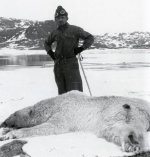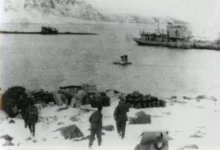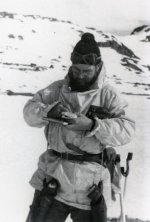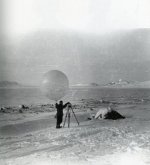jhv 41
Well-known member
OPERATION HAUDEGEN (Swashbuckler):
EUROPE awoke from its five-year nightmare on May 8, 1945, to begin the painful process of reconstruction, reconciliation and retribution.
What no one realised was that a tiny, forgotten outpost of the Third Reich was holding out in the eternal daylight of the Arctic summer, over 2,000 miles away from the ruins of Berlin.
The 11 German soldiers of top secret Operation Haudegen sat tight for four months on the Norwegian island of Spitzbergen, eating canned rations, fending off polar bears, and finally surrendering in September.
They handed over their weapons to a bemused Norwegian Navy captain who had to be talked through the formalities of taking prisoners of war by the Germans themselves.
And with that - on September 4, 1945 - it could be argued that the Second World War in Europe reached its ‘real’ end.
Now, almost 60 years later, the remarkable story of Operation Haudegen can be told for the first time and by the veterans themselves - two of whom were recently reunited for a trip to the island that became their prison.
The hand-picked winter warfare team was sent to Spitzbergen in 1944 on a mission to gather vital weather information for the Nazi war machine.
Heinz Schneider, now 81, was a corporal with the German Marines, an expert in mountain and winter operations, and trained in operating weather equipment.
When word went round in mid-1944 that the German Navy’s weather stations needed volunteers, Schneider, a keen skier, was quick to come forward.
He told Scotland on Sunday: "They asked us whether we wanted to step forward for a mission in the cold and ice, and I decided that was the mission for me. I love skiing - I still do in fact."
Siegfried Czapka, another of the volunteers for the mission, now 80, said: "All we knew was that we were going somewhere where there was ice and snow. That could only mean the Arctic. I was young and believed there were still such things as adventures to be found in the world."
The 11-strong team set out on Operation Haudegen in September 1944 in a U-boat which sailed from the port of Tromsø in German-occupied Norway - a dangerous journey in itself.
The mission was so secret that the unit was not even given a formal name or number, and only referred to by its code name.
Czapka said: "We managed to get through despite an Allied blockade of the Norwegian ports. They were trying to stop us getting through but we managed it."
They set up their camp on Spitzbergen’s east island and began sending weather data from their station to Tromsø.
The German historian and Second World War specialist Franz Selinger, explained: "Getting the weather from so far north was a priority during the war because the air over Iceland is critical in determining the weather patterns over the North Atlantic. If you have people in Spitzbergen, then you know what is on the way."
The information was so militarily sensitive that the weather reports were encoded before being transmitted. In addition to helping the U-boat campaign against Allied shipping, the data helped with the planning for the last attempt to defeat the Allies in the West: the Ardennes Offensive or Battle of the Bulge. The attack began on December 16, 1944, and the bad weather at the beginning of the Nazi push meant that the Allies could not use their stronger air power to stop the advance.
The bitter battle for weather information meant that the Allies sent destroyers to the area with the mission to hunt them down, without success.
Polar bears, however, were another matter, and attacks were common. The men had to carry rifles with them every time they went outside at night in case they were attacked by the bears. They shot four dead, and then looked after the orphaned cubs.
The long Arctic winter nights were spent in learning about science, geography, philosophy and mathematics from the leader of the expedition, Dr Wilhelm Dege.
Schneider said: "Dr Dege was a very educated man, and he felt that because of our situation, with the war and everything, that we hadn’t got a complete education. So he spent time making up for that and teaching us about all kinds of things."
Czapka said: "The worst of it was not knowing what was happening to our families, and they not knowing where we were. The whole operation was so secret. They knew nothing at all about our whereabouts. The Navy told them once a month that their son was in good health, but nothing more."
Then, on May 8 1945, the men received a message from their commanders in Tromsø that the war was over.
They were ordered to dispose of explosives, destroy secret documents and send weather reports unencoded: even the post-war world needed weather information.
Then there was silence. The Spitzbergen team was stranded with only a rowing boat. Although they had perhaps two years of food, the notion of being stuck near the North Pole held little appeal.
At first they waited for a signal from anywhere, hoping that someone might tune in to their weather reports. But they heard nothing.
Czapka said: "We were all worried what had happened to everyone at home. We feared that they had been killed in the air raids. We had been hearing about raids on home towns and cities night after night. We had no idea whether we would find them alive or dead."
Finally, they began sending out signals on Allied distress channels. The Norwegians eventually realised what was happening and chartered a seal-hunting ship to accept the unit’s belated surrender. The vessel got there on September 4, a year after the men’s arrival, and four months after the end of the war in Europe.
Czapka said: "They got us just in time. A few more weeks and the pack-ice would have made it impossible to get through. We would have had to prepare for another winter."
The surrender of Germany’s last known armed unit was, however, farcical.
Schneider said: "The Norwegians came ashore and we all had a big meal together. Then our commanding officer said at the end: ‘I suppose we should surrender now.’ We had this situation where no one seemed too sure what to do."
Dr Eckhard Dege, the son of the German commanding officer, recalls: "My father said he was surrendering. He took out his pistol and placed it on the table in front of the Norwegian captain.
"The Norwegian stared at it and asked ‘Can I keep this then?’ My father explained that he could because they were surrendering - and so they were the last German soldiers in Europe to surrender."
The 11 were taken to Norway and held as prisoners of war for months until being returned to Germany, where they were shocked by the situation.
Schneider, from Dresden, could not believe what he saw: "I had heard that Dresden had been bombed and assumed it was no worse than the bombing anywhere else," he said. "Only when I got there did I realise how much it had been destroyed. It was a terrible sight."
Now the still-intact weather station serves as an emergency refuge for anyone stranded in Spitzbergen.
But the team was split by the Cold War as the Iron Curtain divided their country and Operation Haudegen’s 11 were never united again.
http://einestages.spiegel.de/external/ShowTopicAlbumBackground/a14301/l0/l0/F.html
EUROPE awoke from its five-year nightmare on May 8, 1945, to begin the painful process of reconstruction, reconciliation and retribution.
What no one realised was that a tiny, forgotten outpost of the Third Reich was holding out in the eternal daylight of the Arctic summer, over 2,000 miles away from the ruins of Berlin.
The 11 German soldiers of top secret Operation Haudegen sat tight for four months on the Norwegian island of Spitzbergen, eating canned rations, fending off polar bears, and finally surrendering in September.
They handed over their weapons to a bemused Norwegian Navy captain who had to be talked through the formalities of taking prisoners of war by the Germans themselves.
And with that - on September 4, 1945 - it could be argued that the Second World War in Europe reached its ‘real’ end.
Now, almost 60 years later, the remarkable story of Operation Haudegen can be told for the first time and by the veterans themselves - two of whom were recently reunited for a trip to the island that became their prison.
The hand-picked winter warfare team was sent to Spitzbergen in 1944 on a mission to gather vital weather information for the Nazi war machine.
Heinz Schneider, now 81, was a corporal with the German Marines, an expert in mountain and winter operations, and trained in operating weather equipment.
When word went round in mid-1944 that the German Navy’s weather stations needed volunteers, Schneider, a keen skier, was quick to come forward.
He told Scotland on Sunday: "They asked us whether we wanted to step forward for a mission in the cold and ice, and I decided that was the mission for me. I love skiing - I still do in fact."
Siegfried Czapka, another of the volunteers for the mission, now 80, said: "All we knew was that we were going somewhere where there was ice and snow. That could only mean the Arctic. I was young and believed there were still such things as adventures to be found in the world."
The 11-strong team set out on Operation Haudegen in September 1944 in a U-boat which sailed from the port of Tromsø in German-occupied Norway - a dangerous journey in itself.
The mission was so secret that the unit was not even given a formal name or number, and only referred to by its code name.
Czapka said: "We managed to get through despite an Allied blockade of the Norwegian ports. They were trying to stop us getting through but we managed it."
They set up their camp on Spitzbergen’s east island and began sending weather data from their station to Tromsø.
The German historian and Second World War specialist Franz Selinger, explained: "Getting the weather from so far north was a priority during the war because the air over Iceland is critical in determining the weather patterns over the North Atlantic. If you have people in Spitzbergen, then you know what is on the way."
The information was so militarily sensitive that the weather reports were encoded before being transmitted. In addition to helping the U-boat campaign against Allied shipping, the data helped with the planning for the last attempt to defeat the Allies in the West: the Ardennes Offensive or Battle of the Bulge. The attack began on December 16, 1944, and the bad weather at the beginning of the Nazi push meant that the Allies could not use their stronger air power to stop the advance.
The bitter battle for weather information meant that the Allies sent destroyers to the area with the mission to hunt them down, without success.
Polar bears, however, were another matter, and attacks were common. The men had to carry rifles with them every time they went outside at night in case they were attacked by the bears. They shot four dead, and then looked after the orphaned cubs.
The long Arctic winter nights were spent in learning about science, geography, philosophy and mathematics from the leader of the expedition, Dr Wilhelm Dege.
Schneider said: "Dr Dege was a very educated man, and he felt that because of our situation, with the war and everything, that we hadn’t got a complete education. So he spent time making up for that and teaching us about all kinds of things."
Czapka said: "The worst of it was not knowing what was happening to our families, and they not knowing where we were. The whole operation was so secret. They knew nothing at all about our whereabouts. The Navy told them once a month that their son was in good health, but nothing more."
Then, on May 8 1945, the men received a message from their commanders in Tromsø that the war was over.
They were ordered to dispose of explosives, destroy secret documents and send weather reports unencoded: even the post-war world needed weather information.
Then there was silence. The Spitzbergen team was stranded with only a rowing boat. Although they had perhaps two years of food, the notion of being stuck near the North Pole held little appeal.
At first they waited for a signal from anywhere, hoping that someone might tune in to their weather reports. But they heard nothing.
Czapka said: "We were all worried what had happened to everyone at home. We feared that they had been killed in the air raids. We had been hearing about raids on home towns and cities night after night. We had no idea whether we would find them alive or dead."
Finally, they began sending out signals on Allied distress channels. The Norwegians eventually realised what was happening and chartered a seal-hunting ship to accept the unit’s belated surrender. The vessel got there on September 4, a year after the men’s arrival, and four months after the end of the war in Europe.
Czapka said: "They got us just in time. A few more weeks and the pack-ice would have made it impossible to get through. We would have had to prepare for another winter."
The surrender of Germany’s last known armed unit was, however, farcical.
Schneider said: "The Norwegians came ashore and we all had a big meal together. Then our commanding officer said at the end: ‘I suppose we should surrender now.’ We had this situation where no one seemed too sure what to do."
Dr Eckhard Dege, the son of the German commanding officer, recalls: "My father said he was surrendering. He took out his pistol and placed it on the table in front of the Norwegian captain.
"The Norwegian stared at it and asked ‘Can I keep this then?’ My father explained that he could because they were surrendering - and so they were the last German soldiers in Europe to surrender."
The 11 were taken to Norway and held as prisoners of war for months until being returned to Germany, where they were shocked by the situation.
Schneider, from Dresden, could not believe what he saw: "I had heard that Dresden had been bombed and assumed it was no worse than the bombing anywhere else," he said. "Only when I got there did I realise how much it had been destroyed. It was a terrible sight."
Now the still-intact weather station serves as an emergency refuge for anyone stranded in Spitzbergen.
But the team was split by the Cold War as the Iron Curtain divided their country and Operation Haudegen’s 11 were never united again.
http://einestages.spiegel.de/external/ShowTopicAlbumBackground/a14301/l0/l0/F.html
Attachments
-
 haudegen.jpg57.5 KB · Views: 81
haudegen.jpg57.5 KB · Views: 81 -
 haudegen1.jpg52.5 KB · Views: 81
haudegen1.jpg52.5 KB · Views: 81 -
 haudegen3.jpg43.2 KB · Views: 79
haudegen3.jpg43.2 KB · Views: 79 -
 haudegen6.jpg64.6 KB · Views: 80
haudegen6.jpg64.6 KB · Views: 80 -
 haudegen7.jpg45.9 KB · Views: 77
haudegen7.jpg45.9 KB · Views: 77 -
 haudegen8.jpg48.5 KB · Views: 75
haudegen8.jpg48.5 KB · Views: 75 -
 haudegen10.jpg61.4 KB · Views: 82
haudegen10.jpg61.4 KB · Views: 82 -
 haudegen11.jpg61.9 KB · Views: 77
haudegen11.jpg61.9 KB · Views: 77 -
 haudegen12.jpg64.2 KB · Views: 85
haudegen12.jpg64.2 KB · Views: 85
